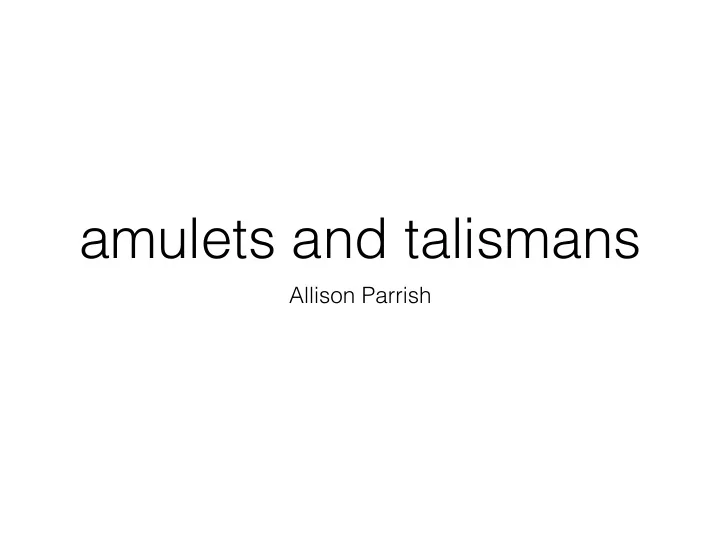

amulets and talismans Allison Parrish
apotropaic (adj). intended to ward off evil from Ancient Greek ἀπό - (apó, “away”) + - τρόπος (trópos, “turn”)
https://en.wikipedia.org/wiki/File:Mezuzah-RS.jpg
amulet (n). "[a] small magical object carried, worn on the body, or kept in one's home... to protect people against evil spirits... enemies... [and] misfortune... [and to] cure specific maladies, or alleviate pain..." (p. 7) from French amulette , Latin amul ē tum (in Pliny the Elder's Natural History ), maaaaybe from Arabic ḥā mala(t) , plural of ḥā mil , lit. 'carrier, bearer, pregnant' (but the OED says "the history of this word shows that the resemblance [...] is purely fortuitous, and there exists no ground for ascribing [it] to an Arabic origin.") Skemer, Don C. Binding Words: Textual Amulets in the Middle Ages. Penn State Press, 2010.
ligatura, phylactery; charta, lamina (on a metal sheet), liettera, brevis, breve, pistol (from Latin epistola ), writ Skemer, Don C. Binding Words: Textual Amulets in the Middle Ages. Penn State Press, 2010.
https://commons.wikimedia.org/wiki/File:Bettelarmband.JPG
Egypt, 3rd century A.D., Papyrus https://deepblue.lib.umich.edu/bitstream/handle/2027.42/108169/def1.display.html
[ia]rbath agrammê fiblô chnêmeô [a e]e êêê iiii ooooo uuuuuu ôôôôôô[ô] Lord Gods, heal Helena, daughter of [...] from every illness and every shivering and [fever], ephemeral, quotidian, tertian, quar[tan], iarbath agrammê fiblô chnêmeô aeêiouôôuoiêea eêiouôôuoiêe êiouôôuoiê iouôôuoi ouôôuo uôôu uuuuu ôô
"Instructions [in this manuscript] call for writing characteres on flexible supports that are to be worn on the body. The characteres include magical script as well as cryptic series of ordinary letters of the Latin alphabet. [...] One recipe calls for the characteres to be written with the left hand (" in manu sinistra ")... Skemer, Don C. Binding Words: Textual Amulets in the Middle Ages. Penn State Press, 2010, p. 81
Pestblätter 'A plague cross with St. Sebastian, St. Roch and St. John Nepomuk. Coloured woodcut.' . Credit: Wellcome Collection. CC BY via http://blog.wellcomelibrary.org/ 2016/10/deciphering-a-central- european-plague-amulet/
talisman (n). any object held to be endowed with magic virtue; a charm (OED) From Arabic ṭ ilsam < Greek τέλεσμα < Ancient Greek τελεῖν 'perform (rites), initiate (in the mysteries)' < τέλος 'end'
The word talisman is derived from the Greek root teleo which means "to consecrate." And it is precisely the act of consecration which gives a talisman its alleged magical powers. For contrary to the amulet [...] the talisman must be "charged" with magical power by the person preparing it. Also, while the amulet is used for general purposes, such as averting evil or attracting good luck, the talisman is always prepared for a definite reason. (p. 203) González-Wippler, Migene. The Complete Book of Amulets & Talismans. Llewellyn Worldwide, 1991.
CBd-1. The Campbell Bonner Magical Gems Database (2010-), developed at the Museum of Fine Arts, Budapest, editor-in-chief: Á. M. Nagy. Retrieved from: classics.mfab.hu/talismans/cbd/1 on 12-04-2018.
magic squares
• More on mezuzas as apotropes: Kosior, Wojciech. “‘It Will Not Let the Destroying [One] Enter.’ The Mezuzah as an Apotropaic Device According to Biblical and Rabbinic Sources1.” A Journal of Orthodox Thought, vol. 16, no. 4, 1977, pp. 7–8. • On Joseph Smith's talisman, see: Quinn, D. Michael. Early Mormonism and the Magic World View. Revised, Subsequent edition, Signature Books, 1998. • The Campbell Bonner Magical Gems Database http:// www2.szepmuveszeti.hu/talismans/ • On magical gems: http://classics.mfab.hu/ antik_gyujtemeny/evszak_mutargya/evszak_en.php?id=624
Recommend
More recommend